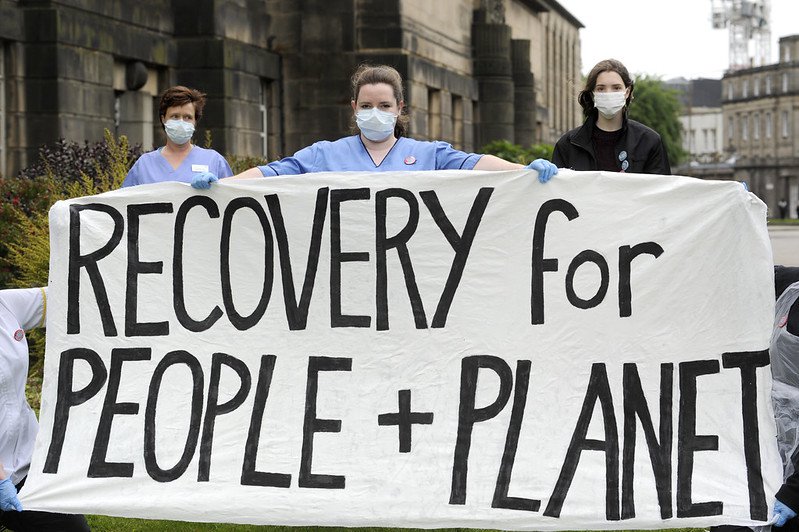The economic impact of Covid-19 has been savage, the greatest disruption to economic activity since the second world war. Economies are in free fall. Already dire forecasts are likely to be revised for the worse again soon. Demand for oil and other commodities has plummeted. World trade has slumped and levels of transportation have dropped sharply.
At the same time, international measures to contain and combat the coronavirus brought a sudden and significant decline in harmful emissions. Before and after satellite imagery from NASA captivated the public; people around the world praised breathing fresh air; inhabitants of northern India marvelled at the sight of the Himalayan mountain range; and even the birds seemed merrier. The positive impact of these developments on climate change could be interpreted as one of the very few – perhaps only – silver linings in the otherwise devastating toll that the coronavirus has wrought on lives, jobs and entire societies across the globe.
The only problem is that the fall in carbon emissions began to reverse as soon as lockdown measures around the world started to lift. But, even if brief, the holiday from emissions highlights the dilemma facing us all. Unless the world seizes the moment to choose a low-carbon future, the quest for a rise in global temperatures by as little as 1.5°C will be as challenging as it was just a few months ago. There will be no guarantee of success in achieving the ambitious goals of the 2015 Paris Climate Agreement.
Putting green at the centre of recovery planning
The economic scars of the pandemic are likely to be deepest among people living in poverty and the least enfranchised sectors of our societies. But however deep these scars, the world will ultimately pull out of this terrible recession.
Quite rightly, governments have sought in the first instance to protect the lives of their people against the threat of the Covid-19 pandemic. And just as justifiably, the next steps have been to achieve a balance between saving lives and stabilising economies, and then preparing for recovery and long-term economic resilience. Unfathomably large sums of money are now targeting that recovery. The key question now is how we use those funds to best effect.
Over the last few months, we have often heard about the importance of “not wasting the crisis”, of “building back better”, and of making sure that spending on recovery also targets a low-carbon future. This is unquestionably valid. However, it would indeed be a grave error to consider spending on ‘greening’ the global economy as no more than an optional add-on to the real business of economic recovery.
The truth is, that green must be at the very centre – not on the periphery – of the recovery planning we do now.
Financing the recovery: the EBRD’s response
The world is not on track to deliver the Paris targets to limit global warming to no more than 2°C, and if possible 1.5°C, to achieve carbon neutrality by 2050 – as was the case even before the coronavirus pandemic. International cooperation across borders, a degree of steady political leadership and decisive actions are required to achieve the Paris Agreement goals and to go carbon neutral by mid-century. This sadly has not been in evidence during this pandemic.
This window of opportunity will not be open for long, nor will the money being made available for recovery come again in time to make the changes we need.
Unless we take the chance to make a green renaissance of this recovery, bringing a more sustainable future with it, we risk replacing one global disaster with a still more far-reaching and irreversible one.The European Bank of Reconstruction and Development (EBRD) is responding to this crisis with its sights fully set on the sustainability of the recovery we are aiming to support. The next stage of the Bank’s Green Economic Transition programme, which will shortly go to our Board for approval, will ensure that climate-friendly projects account for the majority of all our investments.
Building on our strong record to date, in the next five years we will further scale-up our climate and environmental action by verifying the alignment of our operations to the goals of the Paris Agreement. We will do this by:
- Enhancing policy work at the country level;
- Increasing cooperation with other international organisations and by innovating across a range of thematic areas;
- Monitoring every investment to ensure that it meets our stringent environmental standards;
- Working across regions to help countries put in place the policies to help them achieve the Paris goals.
Our work in this field is truly meaningful, as we know that the climate and environmental crisis will have a significantly more severe and long-standing impact than the current health crisis unless we act in time and at scale. Like Covid-19, climate change does not know or respect national borders.
Covid-19 brought a brief respite in the growth of carbon emissions. The challenge now is to achieve a long-term decrease. We must seize the moment to turn the coronavirus crisis into the green opportunity the world needs most.
This blog is part of the ODI at 60 series which explores how to build a better world beyond Covid-19. Join the conversation with #GlobalReset #ODI60.

